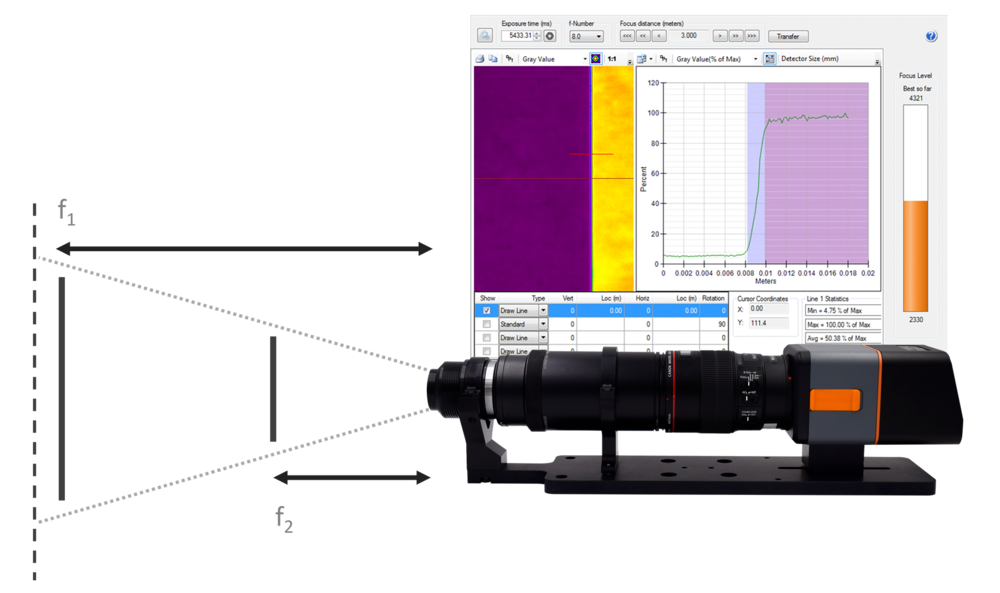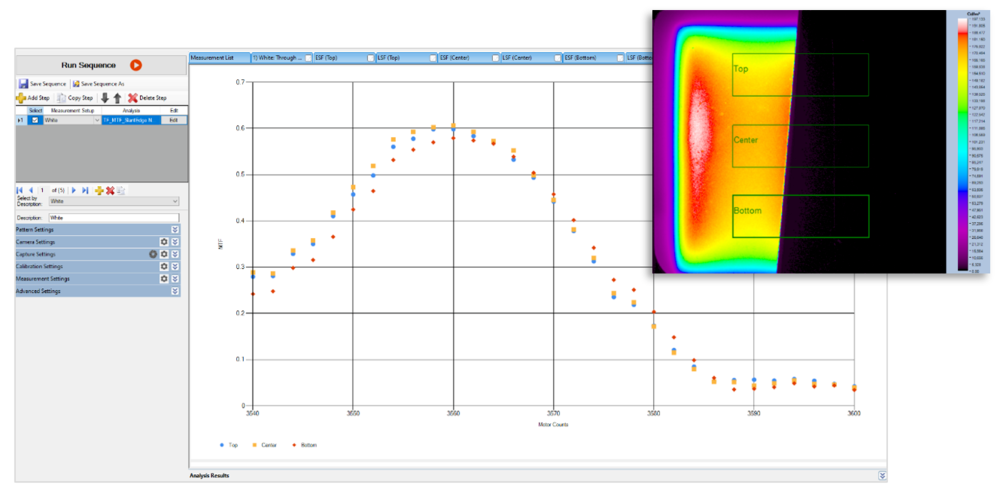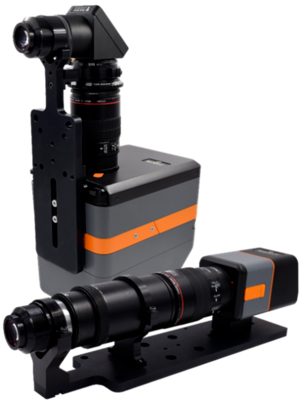The XRE Lens has a distinct optical design that is built specifically for measuring near-eye displays in virtual, mixed and augmented reality headsets. This lens has electronic focus, and it additionally offers dual-eye measurement, as well as folded and non-folded configurations. The lens design simulates the position, size, and field of view of the human eye for measuring in-headset displays.
Some of the main features of the XRE lens are:
- Replicates the human eye (entrance pupil) in headsets
- Available in a non-folded configuration or a folded “periscope” configuration
- Software-controlled electronic focus
- Possesses a field of view up to ±35°, 70° in total
Evaluate XR Displays from the Eye Position in Headsets
The XRE Lens has been designed with a virtual aperture in front of the lens, allowing the system’s optical entrance pupil to be located at the same position as the user’s eye in the headset. The imaging system can capture a 70° display field of view from the near-eye position without any obstruction from headset hardware.
To guarantee that the display meets the expected visual experience, all the aspects of the display are systematically measured.
Since there is no hardware in the virtual aperture of the XRE Lens, worries about mechanical restrictions during positioning the entrance pupil in the headset are eliminated. This makes it flexible to use at the proper eye relief distance for emulating human pupil position.

Image Credit: Radiant Vision Systems
Electronic Focus: Instantly Adjust to Multiple Focal Planes
A realistic view of objects that are nearby and far away is incorporated by multiple or variable focal planes in extended reality (XR) optical designs. To be able to measure elements appropriately, the measurement system must focus at multiple distances.
Manual-focus lenses require longer measurement setup time and can also introduce a risk of error. The focus settings could be inaccurate or can even shift while the measurement is taking place.
Further, in extension-focus lenses, the barrel of the lens changes length while focusing, which causes the measurement system’s entrance pupil to shift from the intended eye position. In these cases, equipment must be relocated prior to additional measurements to ensure proper entrance pupil position.
The XRE Lens’s electronic focus overcomes these issues to offer efficient optimal measurement.
Exact focal distances can be customized in the software to focus the lens to an exact virtual distance from about 0.5 m to infinity. Since the lens has an internal focus system, the lens body’s length is not altered when the focus is changed. Because of this, the XRE Lens system can be tuned without any manual repositioning.
This allows completely automated inspection with focus settings changed in the software. Electronic focus allows automated Through-Focus MTF analysis which iterates through focus settings until best focus is identified across the measurement image. The analysis is completed within a matter of seconds.

Image Credit: Radiant Vision Systems

Image Credit: Radiant Vision Systems

Example of Through-Focus MTF analysis in TT-ARVR™ Software; the XRE Lens system has run through more than 30 focus settings for each measurement region (see inset measurement image) to determine the best-focus result at approximately 3560 motor counts. Image Credit: Radiant Vision Systems
Flexible Configuration Options for Unique Measurement Scenarios
The XRE Lens solution offers many configurations to meet the measurement requirements of fields of view, display type, form factors and resolutions. The XRE Lens can be integrated with an imaging photometer or imaging colorimeter depending on the requirement for color measurement. Resolution choices of up to 61 megapixels offer high pixels per degree for the field of view up to 70° V x H.
Even where headgear or straps are present, folded and non-folded lenses help achieve the appropriate near-eye measurement position in any headset form factor.
Folded configurations allow two XRE Lens systems to be positioned in a headset at the same time for simultaneous dual-eye (stereoscopic) measurement of right and left eye positions. This ensures that the display quality is evaluated under the same circumstances as observed by the user.
XRE Lens solution configuration options:
- Imaging System:
- Colorimetric (luminance and chromaticity)
- Photometric (luminance only)
- Resolution:
- 29 megapixels
- 45 megapixels
- 61 megapixels
- Lens Configuration:
- Folded (“Periscope”)
- Non-Folded
- Additional:
- Dual-eye solution (two integrated XRE Lens systems)
- Standard solution (single XRE Lens system)

Image Credit: Radiant Vision Systems
Pair with ProMetric Photometers and Colorimeters
When the XRE lens is paired with Radiant ProMetric® Imaging Photometer or Colorimeter and software, it offers a holistic solution for precise and comprehensive display measurement in-headset.
The XRE Lens is attached to a ProMetric I Imaging Colorimeter or a Radiant ProMetric Y Imaging Photometer using a mounting bracket to guarantee stability during vibration or any movement. By placing a lens directly on a ProMetric system, the XRE Lens offers a turnkey, compact camera/lens solution for quick application of XR display testing that requires minimal setup, integration equipment, time or skill.
Software Toolset for AR/VR Display Measurement
TrueTest™ Software provides a complete range of Radiant’s display measurement analyses as well as the capability to sequence tests for automated evaluation of all relevant display characteristics within a short span of time.
The TrueTest TT-ARVR™ software module is built specifically to measure AR/VR displays for luminance, uniformity, chromaticity, contrast, mura or blemishes, line defects and pixel defects. Unique tests for XR display analysis such as distortion, MTF, and focus uniformity are also included in the module.
XRE Lens Key Features and Highlights:
- Built for in-headset display testing including measurement of photometric values
- Pairs with high-resolution ProMetric imaging photometers and colorimeters
- Electronic focus for focus setting and adjustment
- Manual adjustment is not required for every focus change
- Allows fully automated Through-Focus MTF testing
- Entrance pupil/aperture in front of the lens to emulate human eye position
- System FOV up to ±35° (70° total)
- Virtual aperture of 3.3 mm allows flexible positioning at several eye relief distances
- Software for analysis and measurement control
Specifications
Source: Radiant Vision Systems
| Parameter |
XRE Lens |
| Primary Application |
Light and color measurement for near-eye displays (NED) in headsets |
| Effective Aperture |
3.3 mm* |
| Focus |
Electronic |
| Focus Distance** |
Range 0.5 m to infinity |
| Minimum Inter-Pupillary Distance (IPD) |
63 mm |
| Fold Length of Optional Fold Mirror |
173 mm |
| Luminance - Minimum |
0.01 cd/m2 |
| Luminance - Maximum*** |
10,000 cd/m2 (Y-series); 1,000,000 cd/m2 (I-series) |
| Measurement Capabilities**** |
Luminance, Radiance, CIE Chromaticity Coordinates, Correlated Color Temperature (CCT) |
| Units**** |
cd/m2, nit, W/sr/m2, foot-lambert, CIE (x, y) and (u’, v’), Kelvin (CCT) |
| Paired with Camera |
ProMetric I29/Y29 |
ProMetric Y45 |
ProMetric I61/Y61 |
Approximate Field of View
(Horizontal) |
±35° |
±35° |
±35° |
Approximate Field of View
(Vertical) |
±35° |
±28° |
±35° |
| Resolution |
0.017° / sensor pixel |
0.010° / sensor pixel |
0.012° / sensor pixel |
*Contact Radiant for relevant drawings.
**Measured from front of lens.
***Maximum luminance is for 1 ms.
****Color measurement available with I-series cameras only.
Typical Applications
The XRE Lens, when paired with Radiant’s highest-resolution imaging photometers and colorimeters, solves diverse measurement requirements of AR, VR and MR headsets. The solution can be used for various research and development and production applications, such as:
- Test and measurement of chromaticity, contrast, luminance, modulation transfer function (MTF), image retention or sticking, image distortion and x,y image position reported in degrees
- Measurement of near-eye displays within the headset
- Perfect for augmented (AR), mixed (MR) and virtual reality (VR) headsets
- Quality control and characterization for devices in both production and research and development (R&D) environments